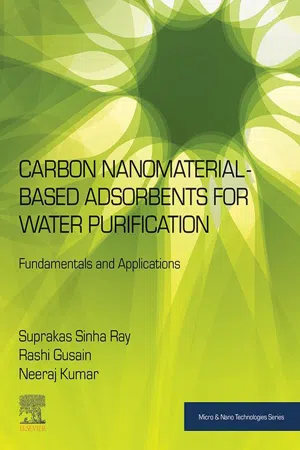
Carbon Nanomaterial-Based Adsorbents for Water Purification
Fundamentals and Applications
- 420 pages
- English
- ePUB (mobile friendly)
- Available on iOS & Android
Carbon Nanomaterial-Based Adsorbents for Water Purification
Fundamentals and Applications
About this book
The deterioration of water quality and unavailability of drinkable water are pressing challenges worldwide. The removal of toxic organic and inorganic pollutants from water is vital for a clean environment, as a response to water scarcity. Adsorption-based water technologies are among the most widely used because of their high efficiency and low cost, without relying on a complex infrastructure. In recent years, carbon nanomaterials (CNMs), such as graphene and derivatives, carbon nanotubes, carbon nanofibers, nanoporous carbon, fullerenes, graphitic carbon nitride, and nanodiamonds have been extensively exploited as adsorbents due to their extraordinary surface properties, ease of modification, large surface area, controlled structural varieties, high chemical stability, porosity, low density, ease of regeneration, and reusability.This book provides a thorough overview of the state of the art in carbon nanomaterials as they are used for adsorption applications in water purifications, as well as addressing their toxicological challenges. This volume primarily explores the fundamentals of adsorption, its mechanical aspects, synthesis and properties of CNMs, and adsorption performances of CNMs and their nanocomposites with organic and inorganic materials. Structural engineering and activation processes produce materials with enhanced adsorptive properties and separation efficiencies. Furthermore, the formation of CNMs with 2D and 3D macro-and microstructures and high porosities is a potential approach to improve adsorption performances and extend CNM use at the industrial level. The book also addresses important issues regarding these adsorbents that potentially affect future research and industrial applications of carbon-based nanoadsorbents in water security.- Presents advances in multifunctional 3D superstructures of carbon nanomaterials and their composites for adsorption applications- Outlines the fundamentals on synthesis and characterization techniques of carbon-based nanostructures and their composites- Assesses the major toxicological challenges in using nanostructured materials as adsorbents for water purification
Frequently asked questions
- Essential is ideal for learners and professionals who enjoy exploring a wide range of subjects. Access the Essential Library with 800,000+ trusted titles and best-sellers across business, personal growth, and the humanities. Includes unlimited reading time and Standard Read Aloud voice.
- Complete: Perfect for advanced learners and researchers needing full, unrestricted access. Unlock 1.4M+ books across hundreds of subjects, including academic and specialized titles. The Complete Plan also includes advanced features like Premium Read Aloud and Research Assistant.
Please note we cannot support devices running on iOS 13 and Android 7 or earlier. Learn more about using the app.
Information
Table of contents
- Cover image
- Title page
- Table of Contents
- Copyright
- Dedication
- About the authors
- Preface
- Chapter one. Introduction
- Chapter two. Classification of water contaminants
- Chapter three. Water purification using various technologies and their advantages and disadvantages
- Chapter four. Adsorption in the context of water purification
- Chapter five. Adsorption equilibrium isotherms, kinetics and thermodynamics
- Chapter six. Effect of reaction parameters on the adsorption
- Chapter seven. Carbon nanomaterials: synthesis, functionalization, and properties
- Chapter eight. Zero-dimensional carbon nanomaterials-based adsorbents
- Chapter nine. One-dimensional carbon nanomaterials-based adsorbents
- Chapter ten. Two-dimensional carbon nanomaterials-based adsorbents
- Chapter eleven. Multifunctional three-dimensional carbon nanomaterials-based adsorbents
- Chapter twelve. Biopolymer-functionalized carbon nanomaterials–based adsorbents
- Chapter thirteen. Conducting polymer-functionalized carbon nanomaterials-based adsorbents
- Chapter fourteen. Carbon-based nano/micromotors for adsorption
- Chapter fifteen. Regeneration and recyclability of carbon nanomaterials after adsorption
- Chapter sixteen. Toxicity of carbon nanomaterials
- Chapter seventeen. Outlook and future research, development, and innovation directions
- Index